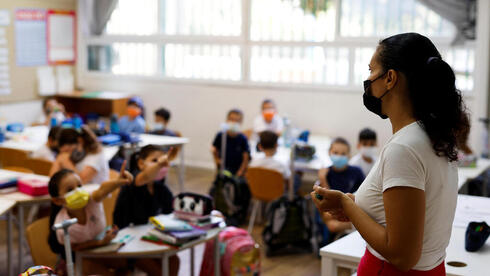The largest ever Israeli climate protest took place in Tel Aviv a month ago. Tens of thousands of people from all over Israel participated. Teenagers skipped school to participate and sent a message to their political leaders demanding that they act on the rapidly changing climate.
The protests sparked a debate about the ages of the participants. Experts analyzed two recent studies to determine the extent to which environmental problems are important to Israeli youth, their feelings of responsibility and where their knowledge comes from.
Electrolux conducted the first study. It involved almost 14,000 participants, all aged between 15 and 25, from around the world, with 1,255 from Israel. According to the survey 46% of Israeli adolescents believe that sustainability is a crucial global issue. 40% believe that they will lead the change towards a better world, while only 6% believe that the older generation will take responsibility.
83% of the 301 Israelis aged between 14 and 25 who were surveyed said they are interested in topics related to sustainability and environment. These teenagers were most concerned about pollution (air, water, and land), natural disasters, climate change, and other environmental issues. A third of those surveyed said they consume content on environment and sustainability every week, mostly via Instagram, news websites and YouTube.
Information transition: From school to social media
There is also a correlation between the various information platforms used by the young generation and their growing awareness of environmental problems.
Dr. Iris Alkaher is a Kibbutzim College senior researcher and lecturer on sustainability education. “One of the most important things that dramatically increased teenagers’ involvement in environmental topics was social media.”
“The informational revolution made the most up-to-date information in the media available to the young crowd. It exposed them to different lifestyles in different places around the world, which awakens thought as well as doubt about how they want to live their life. They are no longer restricted to Israel’s small bubble. Teachers can’t tell them anything, and they don’t know.
According to Electrolux’s survey 80% of Israeli youth believe that education in sustainability fields encourages solutions toward a more sustainable future.
Dr. Alkaher says that the education system doesn’t give enough attention to environmental topics. “In a recent study by Hila Larnao (Tel Aviv University), only 10% of teenagers surveyed said that figures from the formal school system inspired them to deal with climate change,” she states.
5


Greta Thunberg is a Swedish environmental activist, who is well-known for challenging world leaders
(Photo: Reuters)
“They talked about Greta Thunberg and their parents (given their environmental awareness) or their youth movements. If they mentioned the education system, it was almost always in association with disappointment. Their expectation was that the education systems would discuss climate change more.
Dr. Alkaher said that despite this, there has been a recent effort by the Education Ministry and the Environmental Protection Ministry to include topics related to climate change and environmental issues into the formal educational framework.
“Since 2004, certain educational institutions have been awarded the title ‘Green Schools.’ These schools are required by law to teach environmental content, engage with communal environmental projects, minimize natural resource use, and cultivate environmental leaders in students and teachers.
Yael Kobleski was a 12-year-old member of the youth climate group that organized the Tel Aviv march. “At home we have always been aware about the environment, but I didn’t understand the details and extent” she said. Nine months ago, everything changed when I saw a YouTube clip of a polar bear melting icebergs. I cried for two straight days and didn’t know what I could do to help. I then found the Youth Climate Protest Group (Insta) and reached out to them. I was able to make an impact.
Yael Kobleski was 12 years old and a member the youth climate protest group. She helped organize the climate march which took place in Tel Aviv. She says, “At home, we’ve always been conscious of the environment. But I never understood how severe it is.”
“Everything was different nine months ago when I saw a YouTube YouTube video about melting icebergs and polar bears. I cried for two straight days and didn’t know what I could do to help. Then I discovered the Youth Climate Protest Group (Insta) and reached out to them. I was able to make an impact.
Even though Kobleski’s views and activism have changed as a result Instagram and YouTube (much like many others her age), she points out a variety of sources that her knowledge is derived from.
“Social media are what our generation uses, therefore the protest group has an Instagram and TikTok account, Facebook, Twitter, and Facebook account”, she said. “But you can’t be sure what’s real or fake on Instagram so I search Google for information and articles – mostly when someone asks me a question I don’t have the answer to.”
Dr. Alkaher explains that today’s teenagers don’t wait for their teachers to give them the information they need. They can find it online. “This autonomy is something education systems must embrace and encourage students, through it, to find other information sources and examine them.”
The fact that students view teachers’ traditional role as less important than ever doesn’t mean they aren’t influential. She says, “Today, teachers have a different job: To guide and point students in the right direction so they can do the learning themselves about environmental issues, and to encourage students to create a better world.”
The youth as agents for change:
So who will lead this campaign against climate change?
Dr. Alkaher says that “most of the revolutions in this world are led by young people” (climate and environmental topics).
Kobleski’s answers to this question are more complex than those given by the Electrolux survey. She believes that everyone has the power and ability to make a difference. “Governments and politicians can make more changes at the national level than I can, even though I try to minimize my carbon footprint. They can also influence the entire country. It’s clear that our generation is the one that acts most, as we see the dangers and consequences in our futures,” she concludes.






